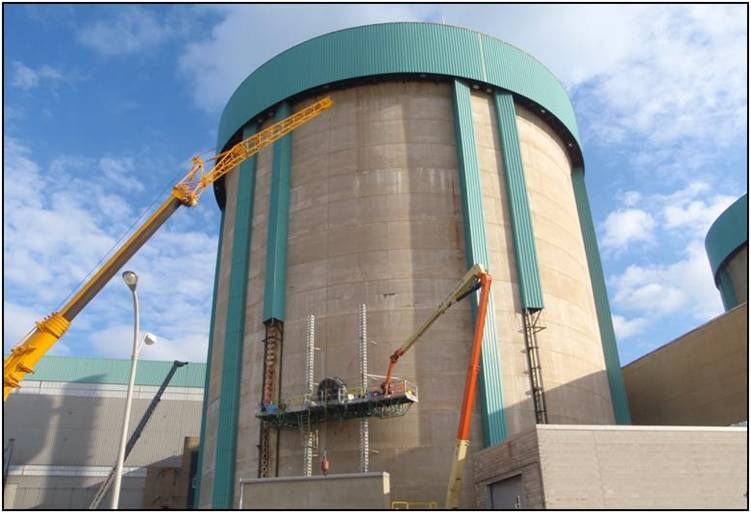What to do with used nuclear fuel, from Illinois to California
By Jeff Terry | December 14, 2018
 Decommissioning work in progress on Unit 2 at the Zion Nuclear Power Plant. (Photo credit: ZionSolutions LLC.)
Decommissioning work in progress on Unit 2 at the Zion Nuclear Power Plant. (Photo credit: ZionSolutions LLC.)
The largest operator of nuclear power plants in the United States, Exelon, closed two nuclear reactors in the city of Zion, Illinois in 1998 because of low demand, which in turn led to poor operating economics. Ever since, these two pressurized water reactors have sat unused on the Lake Michigan shoreline just north of Chicago. Exelon contracted the company EnergySolutions to decontaminate and decommission the site, and this fall it announced it was nearly done, with demolition of the two structures almost complete.
These two closed reactors have been a thorn in Zion’s side since they shut down 20 years ago. The city lost $18 million in annual property tax revenue when the plants closed, and the shortfall had to be made up by local businesses and residents. Beyond the financial loss, the city can’t use the site for parkland, redevelopment, or anything else. But now that decontamination and decommissioning are nearly complete, Zion should be able to reclaim the land and convert it to beneficial use—right?
Not just yet. There is still spent nuclear fuel at the Zion site—bundles of rods of uranium dioxide pellets contained within Zircaloy metal claddings. These used fuel assemblies have been placed in large cylindrical concrete containers, which will be stored at the site on a 3,000 square-meter pad, an area just larger than half a football field. There they will remain in limbo due to the Nuclear Waste Policy Act of 1982. That year, in its infinite wisdom, the US Congress enacted a law saying that “the generators and owners of high-level radioactive waste and spent nuclear fuel have the primary responsibility to provide for, and the responsibility to pay the costs of, the interim storage of such waste and spent fuel until such waste and spent fuel is accepted by the Secretary of Energy in accordance with the provisions of this Act.” In other words, the power plant owner—in this case Exelon—has to hang on to the waste until the Energy Department agrees to accept it. The problem is that the Energy Department won’t accept it, because it has never arrived at an acceptable political solution for dealing with used nuclear fuel. Back in the late eighties, Congress designated Yucca Mountain in Nevada as the nation’s nuclear waste repository, but it has been the subject of political battles ever since, leaving the United States with no place for long-term disposal of nuclear waste.
Other countries have dealt with this problem. France reprocesses used nuclear fuel rods, extracting usable uranium and plutonium and immobilizing the leftover radioactive waste in hunks of glass. Finland has created the Onkalo repository for disposal in metal canisters deep underground. But since the US Energy Department doesn’t have a plan for nuclear waste, it is destined to sit at the Zion site for years, if not decades. A similar fate will likely befall the used fuel stored at other closed nuclear plants around the country, like the San Onofre Nuclear Generating Station in California. As in Zion, the San Onofre plant is located on prime waterfront real estate that local and state government would like to see available for public use as soon as possible.
In general, the US Nuclear Regulatory Commission and nuclear scientists would prefer to come up with a long-term solution to nuclear waste, meaning one that will last for thousands of years. The Yucca Mountain site was supposed to serve that purpose. But they also recognize that short-term or “interim” storage—good for up to 100 years—may be required. The Energy Department and private companies have floated proposals to use temporary sites around the country for short-term consolidated storage of waste from the current fleet of nuclear reactors. For example, Interim Storage Partners has proposed a consolidated storage site for Andrews County, Texas. Just over a decade ago, the American Physical Society released a comprehensive report, “Consolidated Interim Storage of Commercial Spent Nuclear Fuel,” saying that while it tends to prefer a long-term solution, it does recognize that “Consolidated storage could facilitate the decommissioning of sites with reactors that have been shut down.”
There are many closed nuclear plants in the United States that will undergo decontamination and decommissioning, but the Zion plant is an unusual situation, having nearly reached the point at which the land is entirely recoverable except for the lingering issue of used fuel. It is unreasonable to expect cities and towns to deal with land they can’t use, yet can’t collect tax on. Unfortunately, the problems Zion is about to face are just a harbinger of what is likely to happen around the country.
Proposed interim consolidated waste storage sites will probably face lawsuits from non-governmental organizations that don’t like the idea of nuclear waste being stored at temporary locations. Cities and citizens will also likely object to used nuclear fuel being moved along interstate shipping routes, and sue to stop that from happening. Governors will complain about radioactive materials being shipped into their states. This will all increase the amount of time Zion will have to act as a de facto interim waste storage site, without any of the benefits of being an official storage site, such as the potential to attract jobs in waste disposal and possibly enrichment or reprocessing.
There is, though, another potential option. The used fuel at Zion can be stored on only 3,000 square meters of land, an amount that could easily be found at either of the two Energy Department facilities in Illinois, the Argonne National Laboratory and the Fermi National Accelerator Laboratory, both located west of Chicago. It should be possible to move the waste from Zion to either of these sites. No interstate shipping would be required. Either site could store the waste in the same storage casks, on a similar pad. Neither Argonne nor Fermilab are expected to close, and even if they did unexpectedly, it would be decades before the land could be reclaimed for other purposes, which would give plenty of time for the waste to be moved again.
Both of these Energy Department facilities have experience handling radioactive materials. Both have strong research groups focused on radiation damage. They have the expertise to monitor and perform research on any potential degradation of the dry concrete storage containers. In terms of land use, security, and availability of expert staff, Illinoisans would be far better off with the waste stored at one of these sites than sitting in Zion on the shore of Lake Michigan.
Storing the waste in this way would even offer a research advantage. The Energy Department could fully study and document the process of taking ownership of the used fuel. It would end up with a model of safe transportation, storage, and monitoring that could be used to finally establish a process for the spent fuel sitting at other American commercial nuclear reactors. Even if the federal government fails to come up with a final disposition site, California could follow the Illinois model, transferring waste from closed nuclear plants like San Onofre to Energy Department sites within the state, or potentially even Defense Department facilities.
As EnergySolutions has now demonstrated in Zion, the private sector has the ability to decontaminate and decommission closed reactor sites. These places can be returned to public use, but only if the Energy Department finally takes title to the used nuclear fuel as it was obligated to do 20 years ago. We are about to have a restored site that cannot be fully used by the local community due to used fuel. It could easily take more than 10 years for interim storage to open elsewhere, and cities and towns should not have to serve as nuclear waste storage sites in the meantime. The Energy Department should consider moving used fuel to its own facilities within the same state.
Together, we make the world safer.
The Bulletin elevates expert voices above the noise. But as an independent nonprofit organization, our operations depend on the support of readers like you. Help us continue to deliver quality journalism that holds leaders accountable. Your support of our work at any level is important. In return, we promise our coverage will be understandable, influential, vigilant, solution-oriented, and fair-minded. Together we can make a difference.
Topics: Columnists, Nuclear Energy, Nuclear Risk















The Zion and San Onofre nuclear waste is stored unsafely in thin-wall stainless steel canisters vulberable to short-term cracking, leaks and explosions. These pressure vessels are only 1/2″ and 5/8″ thick, respectively, and have no pressure monitoring or pressure relief valves. The concrete overpacks are thick, but have air vents to cool the super hot and highly radioactive fuel inside the thin canisters. Therefore, through-wall cracks in these canisters will release the highly radioactive gases. The Nuclear Regulatory Commission refuses to share with the public the current radiation levels at these air vents. Canisters are welded shut and cannot be… Read more »
You do not know what you are talking about. Nothing you said is true. You sound like a shill for the Greenpeace crowd.
Donna you are correct. You’d have to be a corporate shill to disagree.
Zion closure was not because of a labor dispute, it was 8 courageous operators blowing the whistle on management choices that were endangering the workers and public safety.
Technically, the article is right that moving the spent fuel to the IL labs would free up a small amount of lakefront property and that the already negligible risks would be even smaller. But the truth is that it’s not worth the cost as well as the political capital that will be required to move the fuel (even a short distance). It will be high-profile with a totally unjustified level of news coverage. Baseless nuclear fears will once again be stirred up. Nuclear opponents will have a field day. Given the political capital required, it doesn’t make sense to move… Read more »
The cleanup at the Three Mile Island nuclear plant has ended after 14 years with
The total cost of the cleanup was put at $1 billion.
I agree with the idea that the spent fuel should be moved only as little as possible and left on the surface. We have submitted a petition to the NRC to support the HELMS criteria for the future of nuke waste, including 1000 year life criteria for containers. See more here: http://www.copswiki.org/Common/HelmsProposal
Spent nuclear fuel needs to be dealt with as soon as possible. However, it is not the purview of these labs (especially Fermilab) to deal with commercial spent nuclear fuel. It is the responsibility of the federal government to build a site for this waste and deal with. We need to act like adults about this and consolidate the waste from all of the reactors in one place. Even if everyone is not yet ready to bury the waste, having it all in one place will allow for the reactor sites to become useable again and save on security and… Read more »
What’s the big deal? Unspent reactor fuel has never injured a single human. Don’t real “dangers” leave sick and dead humans, like traffic accidents, smoking cigarettes, guns, etc.? Of course they do. Only invented dangers leave no harm whatsoever. What motivates this exaggeration? There are only two possibilities. First, ignorance. Those making the charges of danger don’t start with facts. Something with zero victims isn’t dangerous- period. Second, the activity in question is threatening profits of another industry. Those profiting want to terminate the threatening source. As is well known atomic energy plants compete with fossil fuel, the energy source… Read more »